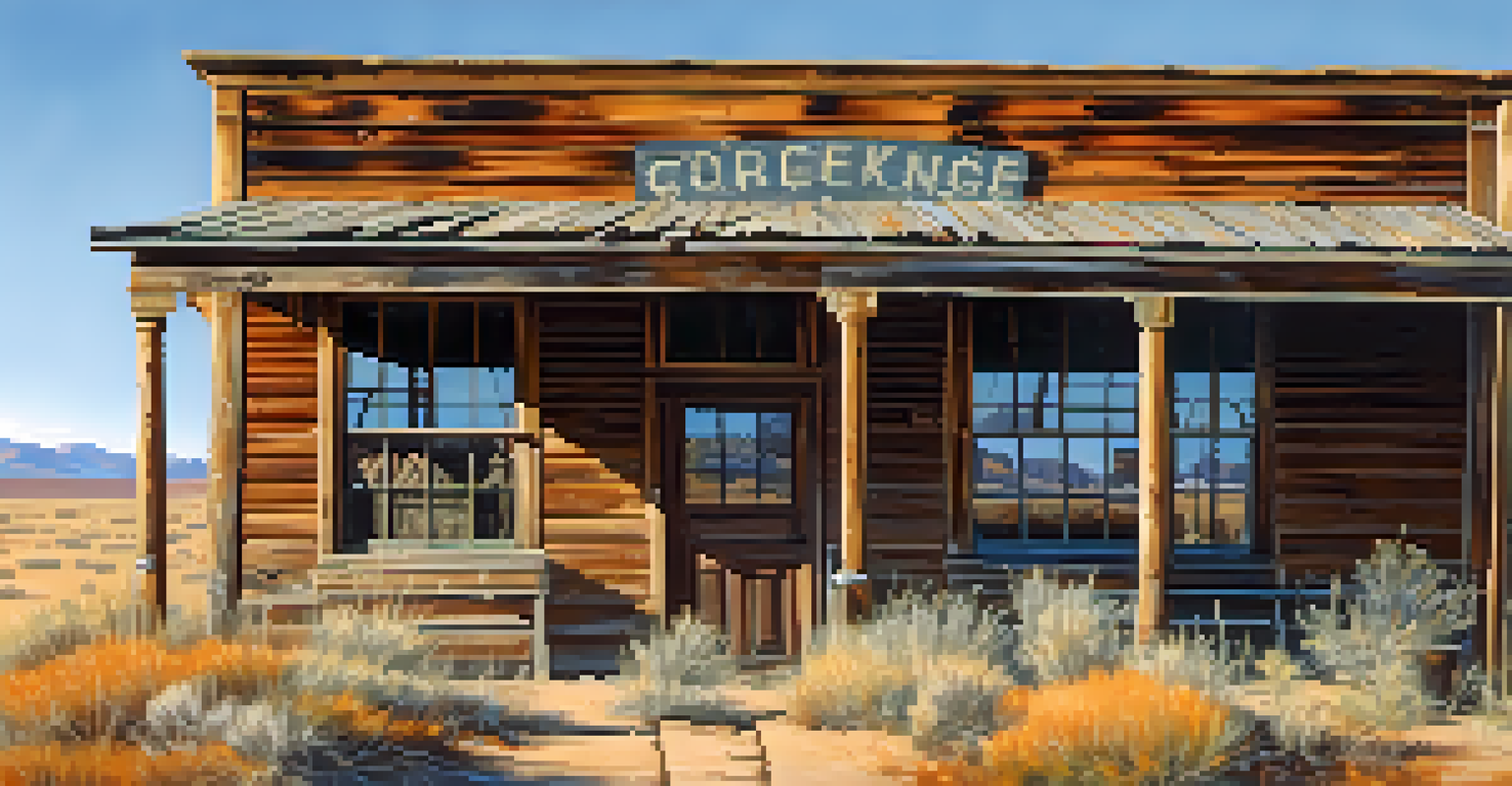The Rise and Fall of Arizona's Historic Ghost Towns

Introduction to Arizona's Ghost Towns
Arizona is known for its stunning landscapes, but lurking within its deserts are ghost towns that tell vivid stories of the past. These once-thriving communities have become time capsules, preserving the echoes of a bygone era. From bustling mining towns to quiet settlements, each ghost town has a unique narrative that contributes to Arizona's rich history.
Ghost towns are the remnants of human ambition and dreams, whispering stories of those who dared to seek fortune.
The allure of these towns often draws adventurers and history buffs alike, eager to uncover the secrets hidden in their crumbling buildings. Many of these towns flourished during the gold rush, as fortune-seekers flocked to the area in hopes of striking it rich. However, as resources dwindled, so too did the populations, leading to their eventual decline.
Understanding the rise and fall of these towns provides insight into the broader economic and social changes that shaped Arizona. As we embark on this journey through time, let's delve into the factors that contributed to the birth and demise of these fascinating ghost towns.
The Gold Rush: The Catalyst for Growth
The discovery of gold in the late 1800s sparked a frenzy of activity across Arizona, leading to the establishment of numerous towns. This period saw a rapid influx of settlers, each hoping to find their fortune in the mines. Towns like Tombstone and Bisbee sprang to life, filled with saloons, shops, and homes, creating vibrant communities almost overnight.

As miners worked tirelessly in search of gold, these towns transformed into bustling hubs of commerce and social interaction. The population boomed, with each new discovery attracting more people, resources, and businesses. This era not only marked the economic rise of these towns but also laid the groundwork for their cultural identity.
Ghost Towns Reflect Arizona's History
These abandoned towns serve as time capsules that reveal the rich and complex narratives of Arizona’s past.
However, the gold rush was a double-edged sword. While it brought prosperity, it also set the stage for future decline, as these towns became heavily reliant on the mining industry. As the gold ran out, the very lifeblood that supported these communities began to dry up, leading to their eventual downfall.
Key Ghost Towns: A Closer Look
Among Arizona's ghost towns, a few stand out due to their unique histories and preserved architecture. For instance, Jerome, once a bustling copper mining town, now offers visitors a glimpse into its storied past through well-preserved buildings and museums. It’s fascinating to wander through the remnants of a town that once boasted a population of over 15,000.
History is not a burden on the memory, but an illumination of the soul.
Another notable ghost town is Bodie, which thrived during the gold rush but fell into decline as mining became unprofitable. Today, it's a protected historic site, where visitors can explore the remnants of its past. Each of these towns, with their unique stories and architecture, invites exploration and reflection on the lives once lived there.
These ghost towns not only serve as a reminder of Arizona's mining heritage but also highlight the resilience of communities during challenging times. As we examine these towns, we gain a deeper appreciation for the stories they hold and the lessons they impart.
Environmental Challenges and Economic Shifts
As time marched on, Arizona's ghost towns faced numerous challenges, not least of which were environmental changes. Droughts and other climate-related issues began to affect the mining operations, making it increasingly difficult for towns to sustain their populations. The reliance on a single resource, such as gold or copper, left these communities vulnerable to the whims of nature.
In addition to environmental challenges, economic shifts also played a significant role in the decline of these towns. As the mining industry became less profitable and alternative industries emerged, many residents chose to leave in search of better opportunities elsewhere. This exodus left behind empty buildings and a sense of abandonment.
Gold Rush Fueled Town Growth
The late 1800s gold rush led to the rapid establishment and subsequent decline of many mining towns in Arizona.
The combination of these factors created a perfect storm, leading to many of Arizona's towns becoming ghost towns. Understanding this interplay between environment and economy sheds light on why some towns persevered while others faded into obscurity.
Cultural Impact of Ghost Towns
Beyond their historical significance, Arizona's ghost towns have had a lasting cultural impact. They inspire artists, writers, and filmmakers, serving as backdrops for creative expression. The haunting beauty of these abandoned places evokes a sense of nostalgia and curiosity, capturing the imagination of many.
Local legends and folklore often emerge from these towns, adding to their mystique. Stories of ghostly apparitions and tales of the Wild West continue to draw visitors, eager to experience the eerie atmosphere. This cultural narrative enriches the understanding of Arizona's history and its diverse communities.
Interestingly, many ghost towns have become popular tourist attractions, offering guided tours and events that celebrate their unique heritage. This revival not only helps preserve the history but also fosters a connection between past and present, illustrating how these towns still resonate with people today.
Preservation Efforts for Ghost Towns
As awareness grows about the importance of preserving ghost towns, various initiatives have emerged to protect these historical sites. Organizations dedicated to historic preservation work tirelessly to restore and maintain the remnants of these towns. Their efforts ensure that future generations can appreciate and learn from these pieces of history.
Many ghost towns have been designated as historic sites, allowing for increased funding and resources focused on their preservation. This not only helps protect the physical structures but also supports local economies through tourism. By promoting these sites, communities can find new life in their historical narratives.
Preservation Efforts Are Vital
Ongoing initiatives aim to protect and revitalize ghost towns, ensuring their historical significance is appreciated by future generations.
Additionally, educational programs and events are being developed to engage the public and raise awareness about the significance of these ghost towns. Through storytelling and hands-on experiences, visitors can connect with the past, fostering a deeper understanding of Arizona's rich history.
The Future of Arizona's Ghost Towns
Looking ahead, the future of Arizona's ghost towns seems promising, thanks to ongoing preservation efforts and growing interest in history. As more people seek authentic experiences away from the hustle and bustle of modern life, these towns are poised to attract visitors who appreciate their stories. This resurgence could breathe new life into the surrounding areas, encouraging local economies to thrive.
Moreover, advancements in technology and virtual reality could offer innovative ways for people to experience these ghost towns. Imagine walking through a digitally reconstructed town or participating in virtual tours that bring the past to life in immersive ways. Such advancements could expand the reach of these historical sites beyond physical visitors.

Ultimately, the story of Arizona's ghost towns is far from over. As we continue to explore and celebrate these remnants of history, we ensure that their legacies endure, reminding us of the vibrant lives that once filled their streets.